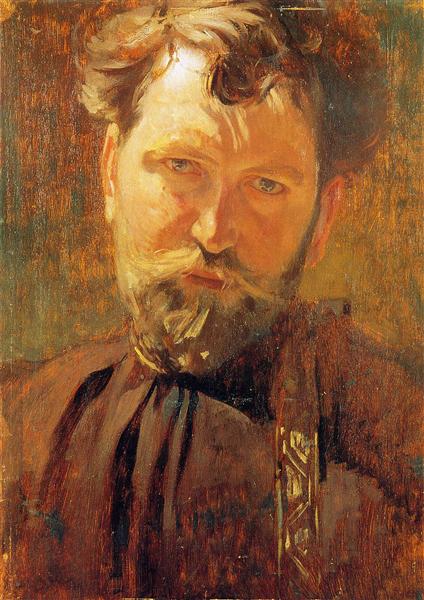Description
Alfons's "self -portrait" of 1899 is a lot of a work that not only reveals the artist's talent, but also offers us a fascinating vision about his style and artistic context. Much, known for his contribution to the Art Nouveau movement, presents in this self -portrait an amalgam of symbolism and refined aesthetics that reflects both his personality and his aspirations as an artist.
The composition of the painting is intimate and direct, focusing on the face of the artist that becomes the focal point of the canvas. The relaxed possession and the use of space in the work transmit a feeling of introspection. Much portrays with a serene expression, which invites the viewer to a personal connection with the artist. The choice of the background, with subtle tones that gently contrast with the features of the face, creates a depth effect that highlights the central figure. This use of negative space is characteristic in many of his works, where what is not shown is as important as what is presented.
The color in this work is remarkable for its warm and terrous range, using gold and ocher that not only serve to clarify the face, but also evoke a sense of warmth and reception. The soft, captured with mastery, emphasizes the three -dimensionality of the much face and reflects its domain in the technique of light and shadow. The golden hair of the artist falls fluidly, a detail that remembers the representations of subtle femininity, omnipresent in his advertising work and in other portraits of often idealized women.
Although this self -portrait does not include additional figures, its uniqueness lies in its ability to be a portrait that communicates the essence of much itself. You can perceive a mixture of humility and pride, an honest representation of a man in search of his place in a world in which he had already begun to leave a significant imprint through his work. The direct look towards the viewer seems to challenge him to know the man behind the work, to understand his personal history and his artistic evolution.
It is interesting to observe that, although the "self -portrait" is a more personal and contemplative work, the themes of symbolism and the desire to capture beauty in everyday life that most promoted through decorative art and illustration are reflected in it. This self -portrait is erected as a testimony of the artist not only as a creator, but as a representative figure of an era that valued art in its multiple manifestations.
Much, often associated with the Renaissance of European decorative art, also left its mark as a graphic designer and its participation in the movement of modernism. His style, full of curvatures and floral forms, had a lasting influence on visual arts. In its self -portrait, despite the absence of the elaborate ornaments characteristic of their largest compositions, the echo of his mastery and his dedication to the form, which made him highlight in an artistic landscape of change and experimentation.
In conclusion, the "self -portrait" of 1899 is more than a simple representation of the author; It is an invitation to explore Alfons's complexity as an artist and as an individual. The work not only captures its physique, but also encapsulates the spirit of a time and a place in art that continues to resonate today. His ability to balance intimacy with a refined aesthetic reveals a depth that continues to fascinate observers and art lovers, consolidating their position in the canon of art history.
KUADROS ©, a famous paint on your wall.
Hand-made oil painting reproductions, with the quality of professional artists and the distinctive seal of KUADROS ©.
Art reproduction service with satisfaction guarantee. If you are not completely satisfied with the replica of your painting, we refund your money 100%.

